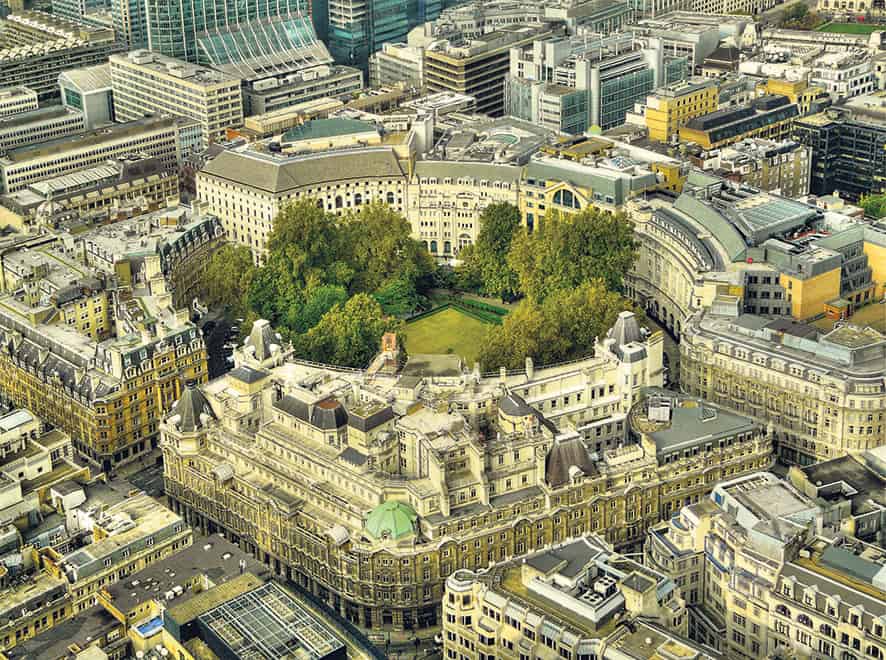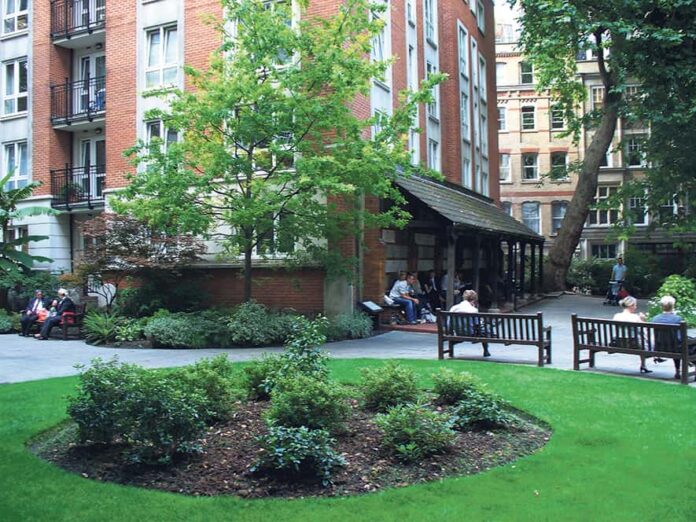The City of London is the centre of world finance, with a history of trade and industry going back to Roman times, but amongst the densely packed office buildings can be found delightful gardens and ‘secret’ places, the discovery of which may take the casual visitor completely unawares.
Many of the gardens were created in Victorian times from existing churchyards, or after the Second World War as a result of enemy bombing. Equally, new gardens are invariably created to complement the latest additions to the City skyline.
Surprisingly, the Square Mile has over a hundred gardens and planted areas – plus one park. These are home to 1,000 trees, with about 100 species, with London planes and limes dominating.
All have to contend with petrol fumes, pigeons, poor soil and ‘canyon winds’ created by high-rise buildings and, in recent years, low rainfall, as well as sandwich eaters and tourists.
Finsbury Circus

The area designated ‘park’ is currently a large hole! Finsbury Circus, the largest open space in the City, was laid out in 1815 by the City Surveyor to designs of George Dance the Younger, a noted architect of the day, on the site of the Bethlem Hospital, also known as Bedlem.
It is temporarily closed because it is being used as an access point for Crossrail. However, the beautiful plane trees have survived and will once again be a worthy backdrop when the garden is re-established. There are several other trees of great worth, one of which is a Sophora japonica or Japanese Pagoda Tree, the only one in the City.
St Dunstan-in-the-East

Perhaps the most atmospheric garden is St Dunstan-in-the-East in Idol Lane. The church, designed by Christopher Wren and unusually in Gothic style, was bombed in 1941 but its walls and tower survived to form the backdrop to a wide range of trees and shrubs.
An unusual small tree with fragrant flowers in spring is a Drimys winteri, typically discovered in the coastal area of Chile.
The glossy leaves are high in vitamin C and were chewed by sailors to prevent scurvy when on long sea journeys. Another interesting tree is a bit of a puzzle, until you know the answer. The long pointed, dark green leaves give no clue to its name – Holm Oak, or Mediterranean Oak.
Christchurch Greyfriars
Another green space created out of the destruction of the Blitz is Christchurch Greyfriars in King Edward Street.
It was replanted in 2001 using an ‘English country garden’ as inspiration. This flower garden has box hedging which picks out the original pew area and wooden ‘columns’ used to train rose and clematis.
In the spring the dominant colours are white and yellow which give way to pinks, reds and blue as summer comes, while towards autumn the colours turn to orange and mauve. This must be the most photographed garden in the City.
Festival Garden
Festival Garden is an elegant and formal square with a lawn and colourful bedding plants all the year round.
It was created on a bomb site by the architect, Sir Albert Richardson, in a classical style to complement the nearby St Paul’s Cathedral in 1951 as the City’s contribution to the Festival of Britain.
He used Portland stone in the structure and included a cascade fountain, one of the few fountains in the City. He also planted a pleached lime hedge around three sides. First used as a defensive feature around medieval villages it is now an attractive feature in formal gardens.
Postman’s Park
Postman’s Park, in St Martin le Grand, is probably the most famous City garden. It got its name because postal workers from the then nearby Sorting Office ate their sandwiches there. In fact, it is a closed churchyard.
When, at the end of the 19th century, City churchyards were closed as a sanitary measure, many were turned into public spaces, which included this garden.
Within the garden is the Watts Memorial Cloister which was the idea of GF Watts, a noted Victorian artist. He proposed the project to be ‘a complete record of the stories of heroism of every-day life’ to mark Queen Victoria’s Golden Jubilee.
Unfortunately, the idea was not taken up, so Watts created the memorial himself. The stories recorded are heartbreaking and a reflection of just how courageous and giving ordinary people can be.
Discovering these gardens and open spaces is a rewarding experience and best explored with a City of London Guide if the real joys of discovery and involvement are to be experienced.
The team of guides, who have completed a training course specialising in the history and horticulture of the City Gardens, conduct walks throughout the summer.
For more info visit the City Information Centre, email citygardenwalks.com, or contact [email protected]







